He is working my Titin
Thoughts
IX
He is working my Titin
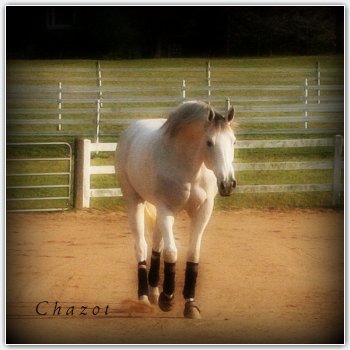
He arrived this morning with a strange smile and announced, I am going to work your titin. He went in the tack room preparing the saddle and Manchester could not stop laughing. Recovering his breath Manchester teased, I cannot wait to see you in a tutu. I corrected him, a little vexed. He did not say tutu, he said titin. Manchester replied, titin sounds to me like a cut-off tutu.
He then walked out of the tack room carrying the saddle and understood by the way I looked at him that he owed me an explanation. He told me, titin is a protein filament that is involved in the spring elasticity of your muscles. He lifted then one finger like a professor and recited a full sentence that he had memorized. “Titin functions as serially linked springs that develop tension when stretched. There are multiple titin isoforms that vary size and stiffness, which explains the elastic-stiffness diversity across vertebrate muscle.” (1)
As he brushes my front legs, he often tells me that I have small feet and almost too fine forelegs for my size. 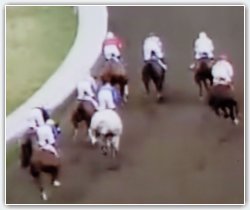 You grew too fast my dear. This was not your fault. The peoples who owned you feed you for performance too early in your life. They wanted you on the racetrack as soon as possible and doing so, they showed poor knowledge and low ethic. A horse of your size should never have been on the racetrack. The only thing we can do now is to increase the density of your bone structure, the strength of your sole and hoof wall, as well as the tone and elasticity of your muscles tendons and ligaments. Thanks to recent research studies, great results can be achieved in the matter through the use of eccentric muscle contractions.
You grew too fast my dear. This was not your fault. The peoples who owned you feed you for performance too early in your life. They wanted you on the racetrack as soon as possible and doing so, they showed poor knowledge and low ethic. A horse of your size should never have been on the racetrack. The only thing we can do now is to increase the density of your bone structure, the strength of your sole and hoof wall, as well as the tone and elasticity of your muscles tendons and ligaments. Thanks to recent research studies, great results can be achieved in the matter through the use of eccentric muscle contractions.
Walking by my side or riding me, he does multiple exercises walking very straight, quite collected and slow down the hill. He started gymnastics in hand. I guess he was concerned by the intensity of the muscular work and used his own body as a test. After all, he was walking down the same hill. I remember the third day of this gymnastic; he was touching his thighs above his knees telling me that he was feeling the work in his knee extensors muscles. I was ready to tell him that he was confusing knee and stifle, but remembered that in terms of comparative anatomy a human knee is an equine stifle. Anyway, we both voted for a light work out this day. 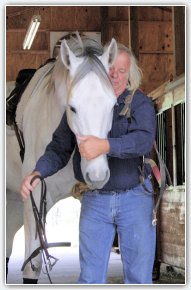
In fact, at the level of my forelegs, I feel his therapeutic work more in my biceps muscles than in my knees. He trots me at a slow jog around the farm asking me constant balance control going up and down light hills. Sometimes we are doing the work at a slow canter and I know how strong I feel after this type of work. The biceps- muscles-tendon units of our front legs are often referred to as a catapult mechanism. Without such system, each one of our biceps muscles would have to weight 50kg, (almost one hundred pounds), to produce enough power to swing the foreleg forward.
If I remember right, the catapult metaphor was proposed by Alan Wilson in reference to the biceps brachii. “This muscle stores elastic strain energy in a thick internal tendon when the muscle is actively stretching during the stance phase. This energy is then released at the end of the stance phase when the leg buckles, allowing the tendon to recoil and catapult the limb forward into the swing phase.”(2) This catapult system enables us to protract the limb more quickly than would be possible with muscle contraction alone. Thanks to such system, we can provide the required power output from only 0.4kg of muscle tissue.
Our biceps is working eccentrically during the whole stance phase, which is the sequence of the stride where the front limb on support remains on the ground. He is very cautious about eccentric contraction. He knows by experience that eccentric contraction can create injuries. He also knows that such powerful contraction can be used to achieve recoveries otherwise impossible. This is why he follows so closely the evolution of equine research studies.
Without adequate knowledge training principles can severely harm us. In turn, without extensive riding experience, scientific findings are not easily applicable. The practical application of scientific knowledge is a science in and of itself. I know first hand how efficient the practical application of scientific knowledge can be, but I also know how cautious he is about integrating new findings. The thought matures in his mind long before he integrates it in our work. He comes in the barn thinking about a recent study and weeks or months later I realize that we are practicing the new discovery.
Sometime, as he is giving me a warm water shower, he follows the line of my muscles with his fingers explaining for himself, how each muscle works. Today, as he was following the shape of my biceps brachii he was thinking, do you know that the length of your biceps muscle fibers varies largely between the fibers situated medial or lateral to your biceps’ internal tendon. The length of the fibers situated on the inside side of the internal tendon, (medial head), are between 5 to 7,5mm. By contrast, the muscles fibers situated on the outside of the internal tendon, (lateral head) are between 22 and 40mm. I believe him on this one. I guess; if the architecture of our biceps muscles have been studied in such details, this must mean that the muscles do have an important role in locomotion.
As I told you, we do not have a training schedule that is as regular as we both would like. He does sustain a heavy clinic schedule and he has to go away frequently. Helyn keeps me in shape in spite of her own workload but this type of specialized work is his duty. Often as he comes back I am ready for more work but he is very cautious. We do not restart where we stop the time before. We restart below where we were during our previous training session. One day I was frustrated in the shower, feeling that I should have worked more. He put the saddle back and we went for a long walk. 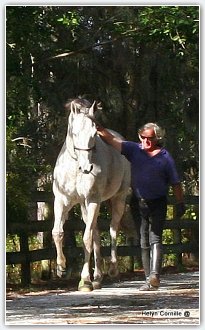 At first I did not listen to his thoughts anticipating that they would be about me being a high maintenance pain in the behind. Instead he was explaining to me the mechanism of eccentric muscle contractions and why such powerful muscle contraction can be dangerous. Eccentric contraction, is a muscle working in isometric hold or concentric contraction, which is elongated by external force such as the knee extensor of a man hiking down the hill, or the biceps brachii of a horse during the support phase of the foreleg. Muscle cells are then developing a surge of power. One of the thoughts is that this intense increase of force is a protective mechanism preventing the muscle cells from being ripped by the elongation. The capacity of muscles’ elongation is very limited. One study stated that the muscles could not elongate more than 2% of their neutral length. The risk of injury is real, especially when training misconceptions believe that active stretching is a compliant elongation of the muscles. In fact active stretching is a powerful muscle contraction. In counterpart, the advantages of eccentric training are enthralling. "For us, as humans, decreases in muscle mass begin to occur as early as 25 years of age. Muscle strength also declines by approximately15% per decade in the sixth and seventh decades. I guess this must be within the same proportions for you as equines.
At first I did not listen to his thoughts anticipating that they would be about me being a high maintenance pain in the behind. Instead he was explaining to me the mechanism of eccentric muscle contractions and why such powerful muscle contraction can be dangerous. Eccentric contraction, is a muscle working in isometric hold or concentric contraction, which is elongated by external force such as the knee extensor of a man hiking down the hill, or the biceps brachii of a horse during the support phase of the foreleg. Muscle cells are then developing a surge of power. One of the thoughts is that this intense increase of force is a protective mechanism preventing the muscle cells from being ripped by the elongation. The capacity of muscles’ elongation is very limited. One study stated that the muscles could not elongate more than 2% of their neutral length. The risk of injury is real, especially when training misconceptions believe that active stretching is a compliant elongation of the muscles. In fact active stretching is a powerful muscle contraction. In counterpart, the advantages of eccentric training are enthralling. "For us, as humans, decreases in muscle mass begin to occur as early as 25 years of age. Muscle strength also declines by approximately15% per decade in the sixth and seventh decades. I guess this must be within the same proportions for you as equines.
Eccentric training permits the slowing down of the process. There is also an element, which is interesting for your specific anatomy. Because eccentric training induces higher muscle force on bone this type of training could increase the density of your bone structure. It has been observed that 18 weeks training on women between 20 and 23 years old, increased mid-femur bone mineral density increases by 3.9%.
I know that he is using eccentric contraction to reinforce my skinny front legs. Even if I do not agree with the size of my legs, I have to recognize that I do feel stronger. In fact when Helyn showed me a picture of me when I was on the racetrack, 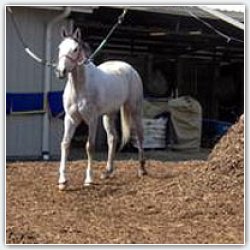 I was so glad that it was not a mirror. Helyn was then kind enough to show me a more recent picture. I have to say that I do like the effects of eccentric training. However, I have to argue about my fine legs. I feel that I am well proportioned and that my front limbs have the same size and strength of my hind legs. He told me, that is the problem. Your front legs should be thicker; they support more load and greater impact forces than your hind legs. Well, I saw him in shorts. I do think that when it comes to skinny legs, he should be the last one to talk.
I was so glad that it was not a mirror. Helyn was then kind enough to show me a more recent picture. I have to say that I do like the effects of eccentric training. However, I have to argue about my fine legs. I feel that I am well proportioned and that my front limbs have the same size and strength of my hind legs. He told me, that is the problem. Your front legs should be thicker; they support more load and greater impact forces than your hind legs. Well, I saw him in shorts. I do think that when it comes to skinny legs, he should be the last one to talk.
“When muscles are activated eccentrically, immediately prior to shortening, they no longer act as shock absorbers; rather they perform more like springs.”(3). Yesterday’s work was a practical application of these scientific findings. We did a type of eccentric training that I do enjoy. I like it because he is working as hard as me and I do feel great coming back home. These training sessions are a combination of work in hand and lunging. They are about creating eccentric muscle contractions immediately followed by concentric contraction (shortening). We are walking, trotting and cantering all around the property and he is using the variations of ground level to work my whole muscular system. Sometime we are walking straight down hill. Other times we are trotting uphill. He lets me turn in circles at the trot, or canter, or walk when the ground is slightly inclined. There are constant variations of straight lines, circles, uphill work, down hill control, etc. In fact, I saw Helyn recording my work with her video camera. I hope they will show you this work. First I feel good about him since I am taking care of his muscle strength. Also, I feel good about myself; the work is fun and while enjoying the warm water shower after work, I do feel that I have worked every single muscle of my body.
I heard him saying, this should be called weight loss lunging. I do feel that this type of work keeps him fit and made him lose some weight. At the contrary for me, I feel that this type of eccentric training is increasing my muscle mass and strength. 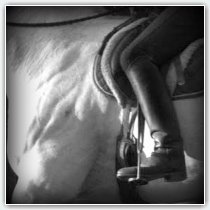
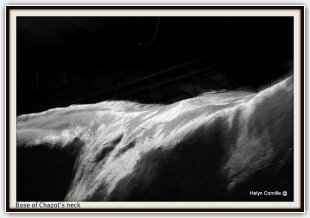
Chazot
Jean Luc Cornille
References
(1) (3) (Paul . LaStayo. PT, PhD. John M. Woolf, PT, MS, ATC. Michael D. Lewek, PT.Lynn Snyder-Mackler, PT, ScD. Trude Reich, BS. Stan L. Lindstedt, PhD. Eccentric Muscle Contractions: Their Contribution to Injury, Prevention, Rehabilitation, and Sport. Journal of Orthopaedic & Sports Pgysical Therapy. Vol 23, Number 10, 2003.)
(2) (Wilson, A. M., Watson, J. C. and Lichtwark, G. A. 2003 Biomechanics: a catapult action for rapid limb protraction. Nature 421, 35-36)



 twitter
twitter facebook
facebook digg
digg stumbleupon
stumbleupon yahoo
yahoo linkedin
linkedin